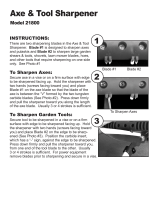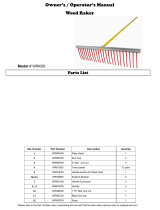
6
7
To achieve the desired results it
is essential that the right file be
used for the job. In selecting the
right file the user should consider
the shape, size and coarseness of
the file.
The size and the coarseness of
the file are directly related, so the
larger the file the more stock it will
remove and the smaller the file the
finer the finish it will achieve.
Most files also have three grades
of cut: bastard-cut, second-cut and
smooth-cut. The coarser the cut
of the file, the rougher the finish of
the work. Therefore, the size of the
file and the grade of its cut must
be taken into account against the
amount of stock to be removed
and the fineness of fi nish that is
required.
Generally speaking bastard and
second-cut grades of double-cut
files would be chosen for the fast
removal of stock while single-cut
files and smooth double-cut files
would be chosen for finishing. It is
however almost impossible to lay
down exact guidelines for the right
file for the job, but using the basic
facts given here the user should
have a reasonably clear picture in
mind, the nature, size of the work,
the kind of finish required, the
working tolerance allowed and the
risks (if any) of spoiling the work.
Choosing the right file
In addition to the amount of stock
to be removed, the contour of its
removal is equally important and is
determined by the shape of the file.
For example, a triangular file should
be used on acute internal angles,
to clear out square corners and in
sharpening saw teeth.
A flat file should be used for
general-purpose work, a square
file for enlarging rectangular holes
and a round file for enlarging round
holes. A half-round file can be used
for dual purposes, the flat face for
filing flat surfaces and the curved
face for grooves.
Filing is an industrial art - grip,
stroke and pressure may vary, to fit
the job. There are three elemental
ways a file can be put to work
They are:
Straight filing: This consists of
pushing the file lengthwise-straight
ahead or slightly diagonally-across
the workpiece.
Drawfiling: This consists of
grasping the file at each end,
pushing and drawing it across the
workpiece.
Lathefiling: This consists of
stroking the file against work
revolving in a lathe.
For normal filing, the vice should
be about elbow height. When there
is a great deal of heavy filing it is
better to have the work slightly
lower. If the work is of fine and
delicate nature, the work can be
raised to eye level.
For work that could become
damaged in the vice through
pressure, a pair of protectors
made of zinc, copper or aluminum
sheet should be used between the
workpiece and vise jaws.
The Grip
For files needing two-handed
operation, the handle should be
grasped in one hand and the point
of the file in the other hand.
The file handle should be rested in
the palm with the thumb pointing
along the top of the handle and the
fingers gripping the underside.
The point of the file should be
grasped between the thumb and
the first two fingers with the thumb
being on the top of the file.
When heavy filing strokes are
required, the thumb on the point is
normally in line with the
How to use a file correctly



















